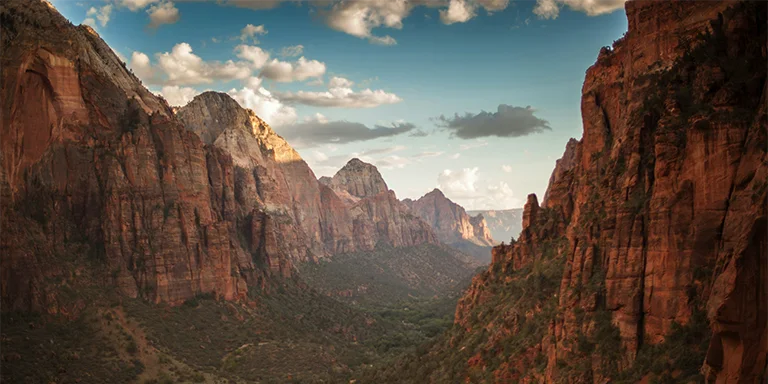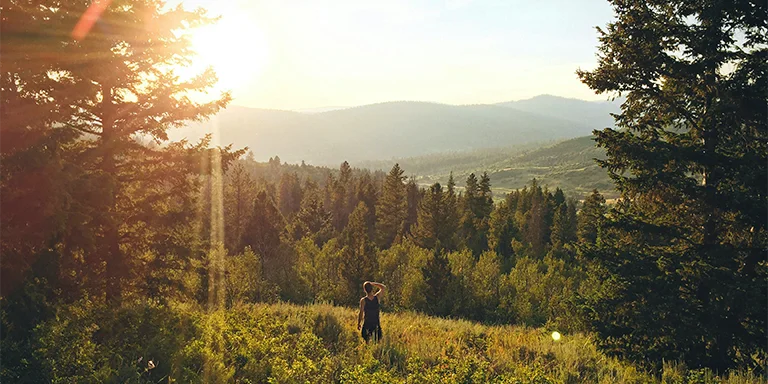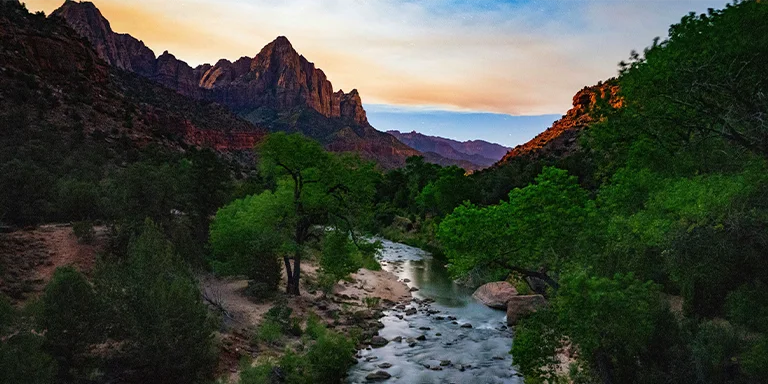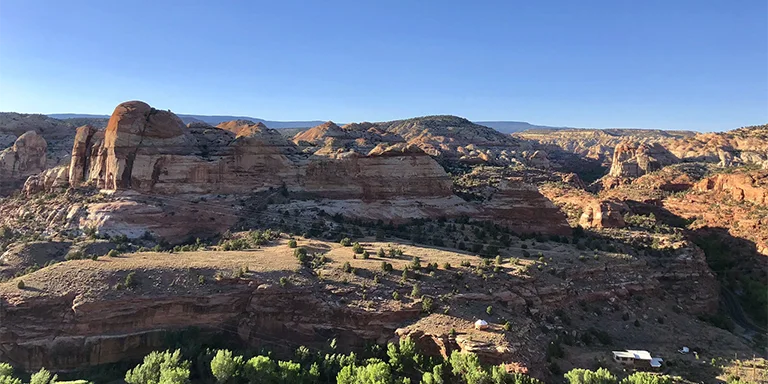

Backpacking in Utah offers immense variety for outdoor enthusiasts, from the rugged peaks of the Wasatch Range to the windswept canyons of the Colorado Plateau, including popular destinations like Zion, Bryce Canyon, and Arches National Parks.
And that’s what this post is all about – backpacking in Utah. We’ll provide tips to help you prepare for backpacking in this diverse state as well as showcase the TOP 5 multi-day trails in Utah.
Interested? Let’s get started.
Discover Utah’s finest multi-day trails:

Length: 30.6 mi / 49.2 km
Type: Loop
Difficulty: Hard
Elevation Gain: 6328 ft / 1929 m
Location: Zion National Park
Estimated Hiking Calorie Burn: 4200 calories
More Details: See on AllTrails
The stunning 30-mile West Rim Trail in Zion National Park is a challenging yet rewarding backpacking trip, taking about 15 hours to complete. Wending through beautiful canyons and rock formations, the trail offers spectacular views, diverse terrain, and opportunities to see wildlife. Backpacking March through October is ideal, though be prepared for some crowds. Highlights include Angels Landing for thrill-seekers and the chance to camp overnight mid-hike at designated backcountry sites. Be sure to bring plenty of water and backpacking supplies for this desert hike.

Length: 101.6 mi / 163.5 km
Type: Point to point
Difficulty: Hard
Elevation Gain: 18 097 ft / 5156 m
Location: Ashley National Forest
Estimated Hiking Calorie Burn: 13 300 calories
More Details: See on AllTrails
The challenging 100-mile Highline Trail in the High Uintas Wilderness is a premier backpacking route, taking about 5 days to complete. Following the Uinta Mountains from Mirror Lake to Vernal, the trail stays above 10,000 ft. with epic vistas. Hiking June through October is best, though prepare for wet conditions and varied weather. Being a popular trail, expect to see fellow backpackers. Highlights include vast meadows, alpine lakes, and peaks over 13,000 ft. Start from Mirror Lake or Leidy Peak trailhead. Be ready for substantial deadfall near Rocky Sea Pass. Camp at scenic sites like Deadman Lake.

Length: 37.6 mi / 60.5 km
Type: Point to point
Difficulty: Hard
Elevation Gain: 2700 ft / 823 m
Location: Grand Staircase – Escalante National Monument
Estimated Hiking Calorie Burn: 4000 calories
More Details: See on AllTrails
The challenging 38-mile Paria Canyon Trail from White House to Lees Ferry is a premier Utah backpacking route through the longest slot canyon in the world. Hiking March to June is best to avoid extreme heat and flash flooding. Expect solitude on the trail with few fellow backpackers. Highlights include magical narrows, rock formations, and desert wildlife. Multiple campsites dot the trail, like Big Spring and Bush Head Canyon (permits required). The best time to embark on this remote canyon hike is fall when temperatures are mild.

Length: 49.7 mi / 80 km
Type: Point to point
Difficulty: Hard
Elevation Gain: 8467 ft / 2581 m
Location: Zion National Park
Estimated Hiking Calorie Burn: 6500 calories
More Details: See on AllTrails
The challenging 50-mile traverse from Lee Pass to Zion Canyon is an epic Zion backpacking trip for experienced adventurers. Using connected trails like La Verkin Creek, Hop Valley, and the renowned West Rim, the route spans Zion from north to south. Hike April to September for ideal conditions. Though popular, the trail allows for solitude during quiet times. Highlights include diverse landscapes, reliable springs, and remarkable viewpoints. Descending into Zion Canyon brings larger crowds. Be prepared for bugs in some areas and sandy trails.

Granger Meador, CC BY-SA 2.0, via flickr
Length: 34.9 mi / 56 km
Type: Loop
Difficulty: Hard
Elevation Gain: 6407 ft / 1953 m
Location: Box-Death Hollow Wilderness
Estimated Hiking Calorie Burn: 4700 calories
More Details: See on AllTrails
The challenging 35-mile Death Hollow Loop in Utah is an epic backpacking adventure, taking 2-3 days to complete. The route descends into Death Hollow Canyon to the Escalante River, then follows the river upstream to the Boulder Mail Trail. Highlights include petroglyphs, natural bridges, and diverse desert scenery. Hike February to November for ideal conditions. Though popular, the loop allows solitude during quieter times. Be prepared for rugged terrain, river crossings, overgrown brush, and poison ivy.
In Utah, you should be prepared for rapidly shifting mountain weather:
Prior to choosing your gear, review the weather data for Utah (Cedar City):
| Jan | Feb | Mar | Apr | May | Jun | Jul | Aug | Sep | Oct | Nov | Dec | |
|---|---|---|---|---|---|---|---|---|---|---|---|---|
| High °F | 41 | 45 | 54 | 61 | 71 | 82 | 87 | 85 | 77 | 65 | 51 | 41 |
| Low °F | 19 | 23 | 40 | 47 | 56 | 67 | 73 | 71 | 62 | 50 | 37 | 28 |
| Rainy days | 4 | 5 | 5 | 4 | 3 | 2 | 4 | 5 | 4 | 4 | 3 | 4 |
Not sure if Utah is right for you?
Don’t forget to check out our backpacking guides for Nevada and Colorado.
When backpacking in Utah, campfires are usually restricted or prohibited to prevent wildfires in the dry climate. Public lands like national parks, monuments, forests, and recreation areas often ban campfires outside designated areas. In backcountry camping areas, you may need a portable stove for cooking, and gathering wood might be prohibited.
Pack plenty of water and electrolyte supplements to avoid dangerous dehydration in the dry climate. Carefully check weather and avoid hiking narrow canyons during monsoon season when deadly flash floods can occur. Guard against sunburn, heat exhaustion, and dehydration by covering up, wearing sunscreen, and hiking during cooler hours. Carry detailed topo maps and a compass or GPS device and know how to navigate with them. Share your hiking plans and itinerary with someone beforehand and consider carrying a satellite communication device on longer trips. Wear sturdy, broken-in hiking boots with good ankle support and tread to negotiate the rocky, uneven terrain and use trekking poles for added stability. Watch out for rattlesnakes, black widows, scorpions and other hazards. Apply insect repellent and wear long pants and sleeves. Take a wilderness first aid course and carry a well-stocked medical kit for emergencies. Practice Leave No Trace ethics when camping and take steps to properly store food and supplies. Pack essential but lightweight backpacking gear like a tent, sleeping bag, cookware, and lighting. Following these tips will help ensure you safely enjoy the immense beauty and adventure of backpacking in Utah’s magnificent but unforgiving backcountry.
Be cautious of potentially dangerous animals like bears, mountain lions, rattlesnakes, and spiders in Utah’s wilderness. Make noise while hiking to avoid surprising them, and give them plenty of space without approaching or interacting. If you encounter a mountain lion, stand still and make yourself appear large. In rare bear encounters, speak calmly, back away slowly, and be prepared with bear spray. Watch where you place hands and feet to avoid snakes near logs or rocks, shake out shoes before wearing, and carry snake bite kits and know first aid. Never feed or approach wildlife, regardless of how harmless they may seem.